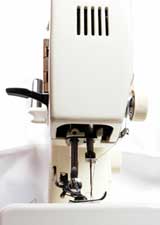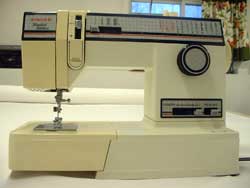Tips On Finding Great Used Sewing Machines
Since used machines cost less than newer ones with the same qualities, you are getting a great deal and saving money over what a similar machine would cost you to buy new.
Where Should You NOT Buy Used Sewing Machines?
Although it might be the cheapest alternative initially, picking up a sewing machine at a garage sale, auction or antique shop has risks. You won't know if it is in good working order until you get it home and try it out. You may find that parts are missing or broken.

Finding and replacing any necessary parts may be difficult. Unless you are the type that likes to tinker, you may have to pay yet more money to get the machine serviced.
Try to find a machine from a company that is still in business and you are more likely to have success with servicing and finding parts. If the owner’s manual is missing, check with the manufacturer - they will often be able to provide you with a replacement.
Buying a used machine from a newspaper advertisement or even from someone you might not know very well could be risky. Be careful not to buy a machine and end up with somebody else's problems. There's no guarantee with this type of sale once your money has changed hands.
Your Best Choice For Buying A Used Sewing Machine
Your best option is to buy a used machine from your local sewing machine repair shop as they often accept trade-ins of older machines on purchases of new machines. Those trade-in machines are then serviced and resold with a warranty - don't forget to ask about the warranty.
This is the most reliable way of knowing your machine will be in great working order when you buy it. You'll also have the chance to test it out before buying. The dealer will even show you how to operate and adjust your used sewing machine and go over its functions and stitches with you.
My Old Standby Machine

This is my old machine I bought around 1990. I use my industrial machines most of the time for my drapery business. However, from time to time I do pull this older machine out for button holes or a stitch my industrial can't do. Although this is a basic machine by today's standards, it meets all my needs just fine.
Some of the features of this machine include:
- Electronic Speed Control
- Auto Tension - You don't have to adjust the tension for most of your sewing projects
- A Wind-In-Place bobbin - The bobbin is wound without having to take it out of the machine
- A Removable Bed Extension for flat and free-arm sewing
- Four Step Buttonholing
- 9 Special Stitches, including the blindstitch which is useful for machine hemming
Try A Machine Before You Buy It
Let the dealer know what type of sewing you plan to use your machine for so they can help you pick the best machine for your needs. Take along some sample fabric scraps and make sure you have the chance to sew on the machine yourself (rather than just watch the salesperson sew with it).
Try threading it. Adjust the tension. Make sure you are comfortable using it. Ask the dealer what other options are available to buy later if you decide you need them. Here are some of the Popular Basic Features to look for on a used sewing machine:
- An Electronic Machine - they are faster, adjust easier, and are just more efficient than mechanical machines
- Zigzag Stitch
- Automatic Button Hole Attachment
- Blind Hem Stitch
- Free Arm Sewing bed
- Seam Allowance guide located on the throat plate
- All-purpose foot
- Zipper Foot
Related Articles
Go to CreativeSewingTips.com Home Page




